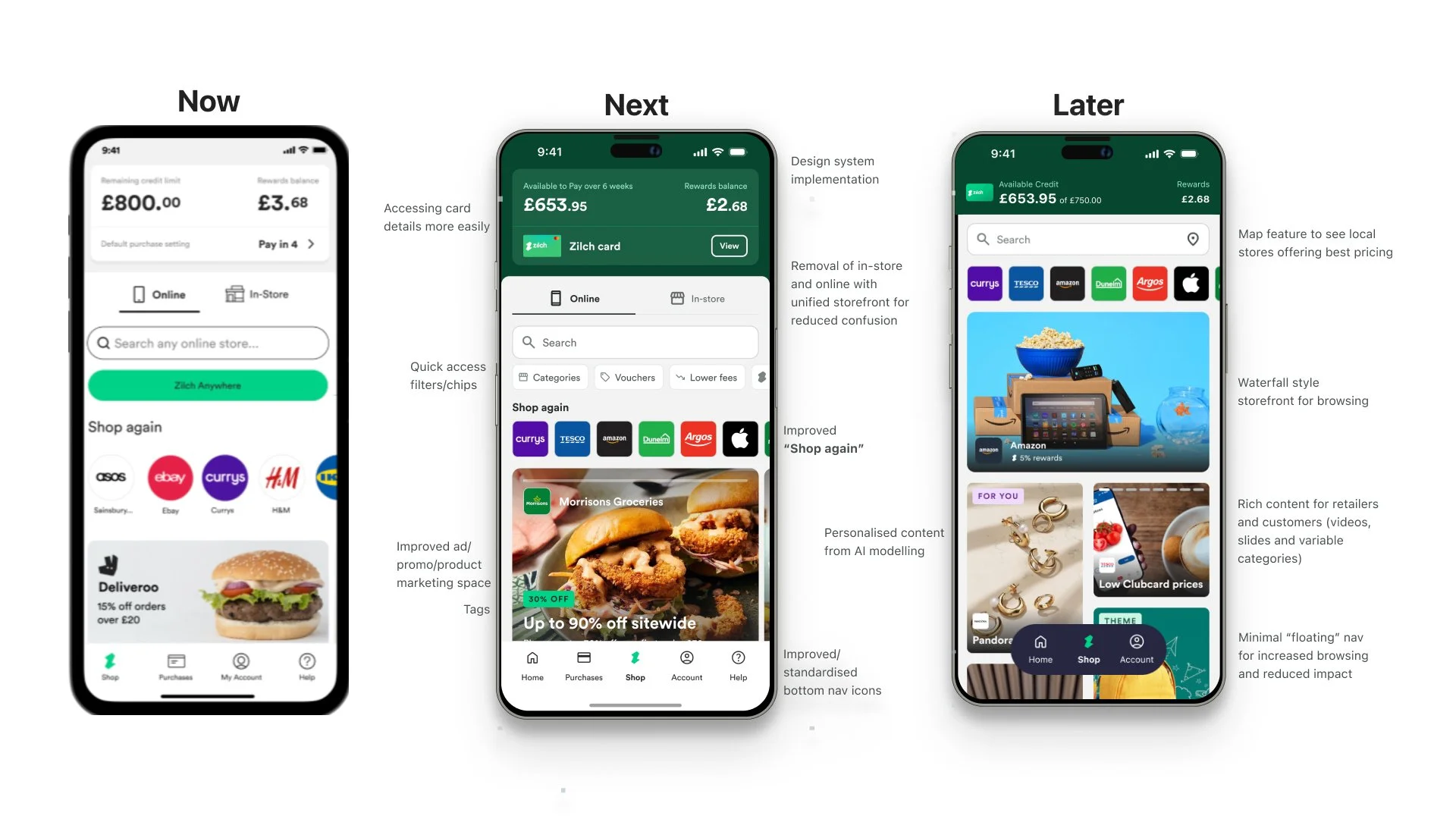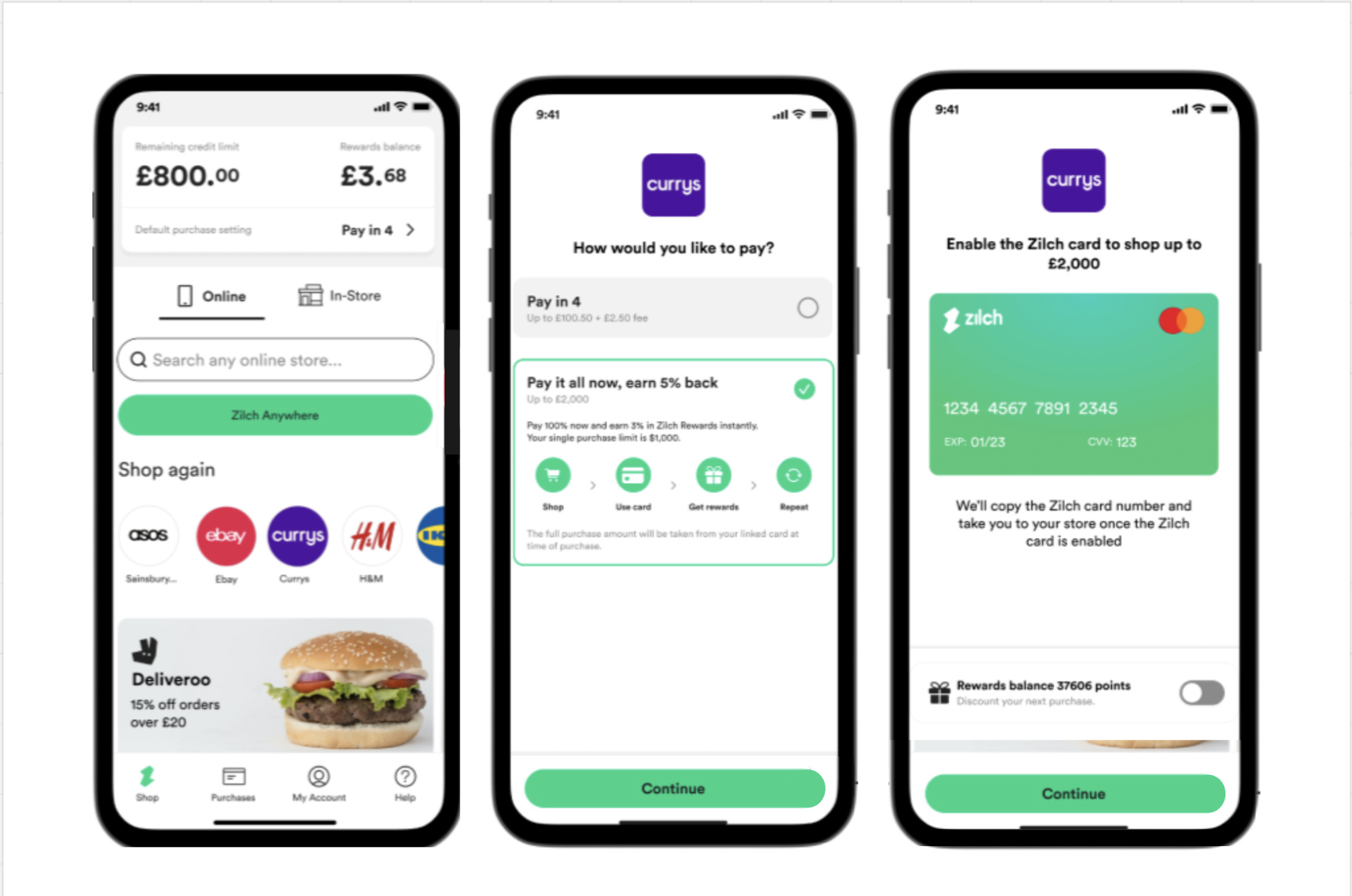
Driving £130M+ in revenue through storefront strategic vision
Results:
+11% uplift in retailer diversity per customer
+16% increase in browsing time
+14% more customers shopping outside their “core 3” stores
-8% reduction in M1→M2 drop-off
Higher merchant subsidy revenues and increased dormant-user reactivation
TL;DR
Redesigned Zilch’s storefront from a static, ad-heavy catalogue into a dynamic, intent-based experience. By aligning design, marketing, and compliance, we unlocked the metrics above.
The result: the storefront became a strategic growth driver, increasing merchant subsidies, reactivating dormant users, and positioning design as a partner in revenue growth.
Executive Summary
The Challenge:
Zilch’s storefront had become seen as static, ad-heavy, and uninspiring. 80% of customers shopped only with their initial 2-3 retailers, compared to an industry benchmark of 5-7. The app was seen as a “means to an end,” rather than a daily value-driver.
The Stakes:
Retailer subsidies at risk, low customer lifetime value, and high early drop-off rates (M1→M2) threatened frequency, retention, and perceived product value.
The Transformation:
In 18 months, we redesigned the storefront into a dynamic, intent-based, AI-enabled experience. Content shifted from static brand lists to personalised, need-based recommendations aligned with customer behaviour, timing, and location.

Context & Problem
When I joined, Zilch’s storefront was one of its weakest-performing assets but talked about the most as the way to make credit affordable for customers:
Static, brand-led layout — dominated by ads rather than customer value.
Low engagement — most customers never explored beyond their first few purchases.
Concentration risk — 80% of customers shopped with only 2–3 retailers.
Missed opportunity — the app lacked role in customers’ daily lives beyond fast credit.
Customer insight: Users weren’t simply looking for brands. They wanted to solve real-life problems — groceries for the week, last-minute gifts, payday splurges, or urgent needs. The storefront wasn’t designed to meet these moments.
“Zilch is a means to an end, not part of my daily life.”
Vision & Strategy
North Star
From static, one-size-fits-all catalogue → to dynamic, intent-based, personalised storefront aligned with customer context.
Core design principles
Intent-based entry points (e.g. groceries, clothing, delivery, essentials).
Timing triggers (payday, month-end, emergencies, self-treats).
Location-aware engagement (prompts tied to where customers are).
Personalisation (preferences, browsing history, AI recommendations).

Leadership & Execution

This transformation required leadership across design, product, and marketing:
Cross-functional alignment: Weekly CMO syncs and embedded marketing input into design reviews.
Compliance by design: FCA Customer Duty integrated into storefront experiences.
Scalable systems: New design system components for storefront cards, category layouts, and content slots.
Team growth: Designers accountable for KPIs such as frequency, retention, and subsidy contribution.
Business Impact Timeline

Results & Outcomes
Customer & Business Metrics
+11% retailer diversity per customer
+16% browsing time
+14% customers shopping beyond “core 3” stores
-8% M1→M2 drop-off
Increased merchant subsidy revenues
Higher reactivation rates for dormant users

Leadership Lessons & Strategic Insights
1. Customer problems, not brand lists, drive engagement - Meeting real-life needs (budget pressure, speed, family, self-treats) delivered more loyalty than logos.
2. Design as growth driver - By reframing the storefront around customer intent, design unlocked new P&L opportunities.
3. Alignment is everything - Weekly syncs with marketing + compliance integration turned design from a bottleneck to a partner.
4. Vision must cascade - The intent-based strategy worked because it became embedded in every team’s daily decisions.
Future Vision
Looking forward, this redesign lays the foundation for:
AI-powered personalisation at scale (real-time recommendations).
Deeper retailer partnerships through contextual placements.
Customer habit-forming loops (storefront as daily shopping destination).
Financial Information and help at customers fingertips.
